Summary
- Improvement of corn hybrid genetics for superior stress tolerance has allowed hybrids to be planted at higher plant populations and produce greater yields.
- Over the past 30 years, average corn seeding rates used by corn growers in North America have increased by about 275 seeds/acre per year, while U.S. average yields have increased by about 2 bu/acre per year.
- Each year Pioneer evaluates corn plant population responses in research trials that span the Corn Belt of North America. Pioneer researchers target representative environments based on maturity zone, expected yield (high or low), specific stresses, and other unique location characteristics.
- Farmers can use the multi-year and multi-location results to identify the best potential planting rates specific to their hybrid, location, and management practices.
- The economic optimum seeding rate (the point at which profitability is maximized) will always be a bit less than the seeding rate at which yield is maximized.
- In challenging emergence environments, farmers may need to increase rates. See seeding rate tips in this article or contact your local Pioneer sales professional for help.
Higher Density Drives Higher Yields
One of the most critical factors in achieving high corn yields is establishing a sufficient population density to allow a hybrid to maximize its yield potential. Historically, population density has been the main driver of yield gain in corn. Improvement of corn hybrid genetics for superior stress tolerance has allowed hybrids to be planted at higher plant populations.
The continual increase in optimum plant density throughout the hybrid corn era has been well-documented by research. An analysis of Pioneer plant population data from the past 30 years has shown that this trend continues up to the present day (Ciampitti, 2018a). Additionally, this analysis showed that the range of the agronomic optimum plant density increased over time from the 1987-1991 period to the 2012-2016 period (Figure 1). This finding shows that modern hybrids not only need more plants to attain maximum yields, but also that the stability of modern hybrids has increased relative to older hybrids.
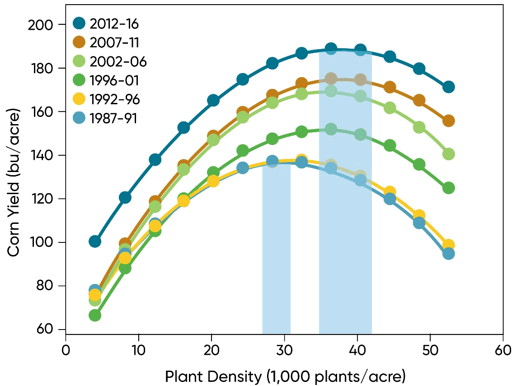
Figure 1. Agronomic optimum plant density (averaged over all Pioneer® brand hybrids) over six 5-year time periods from 1987 to 2016. Shaded bars show the increase in agronomic optimum plant density range from the earliest time period in the study to the most recent.
Plant Population Trends
Farmers have taken advantage of the higher stress tolerance of modern hybrids by pushing plant populations higher. The linear increase in average plant populations used by corn growers in North America tracks closely with the linear increase in average corn yields over the same time period. Since 1986, average corn seeding rates used by growers in North America have increased by about 275 seeds/acre per year, while U.S. average yields have increased by over 2 bu/acre per year (Figure 2).
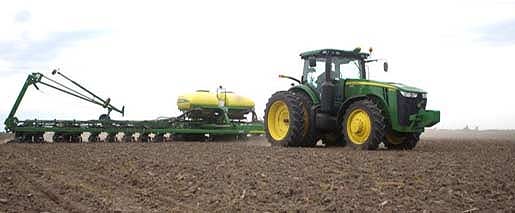
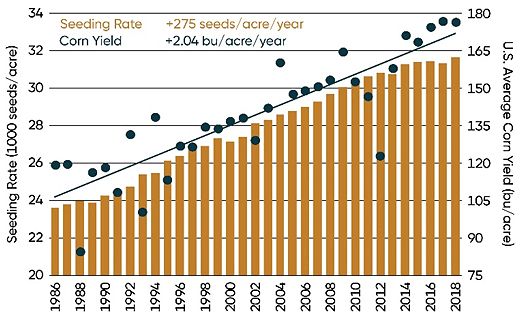
Figure 2. Average corn seeding rates reported by growers in North America (Pioneer Survey, 2018), and average U.S. corn yields (USDA NASS).
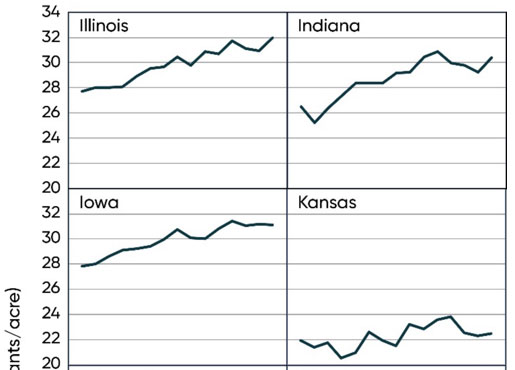
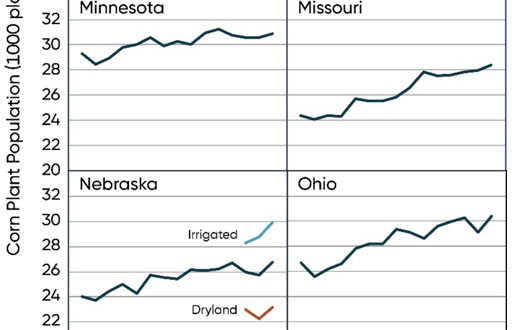
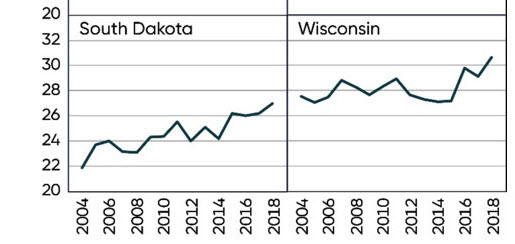
Figure 3. Average corn plant populations for major corn-producing states, 2004-2018 (USDA NASS).
Corn plant populations vary by geography due to differences in growing environments and productivity levels, but populations have generally trended upward over time. The ten corn-producing states for which the USDA collects corn plant population data have all had positive linear trends over the past 15 years (Figure 3). Wisconsin and Kansas had the smallest increases over this time period, with an average gain of around 125 plants/acre/year, while Indiana, Illinois, Missouri, and Ohio had the largest increases at over 300 plants/acre/year.
Pioneer Plant Population Research
Pioneer has been conducting plant population studies with corn hybrids for over three decades. Research studies have been conducted at over 320 locations throughout the U.S. and Canada in the last 6 years (Figure 4). Pioneer researchers target representative environments based on maturity zone, expected yield (high or low), specific stresses, and other unique location characteristics. Over the past several years, Pioneer has also conducted plant population research focused specifically on lower-yielding water-limited environments (Figure 5).
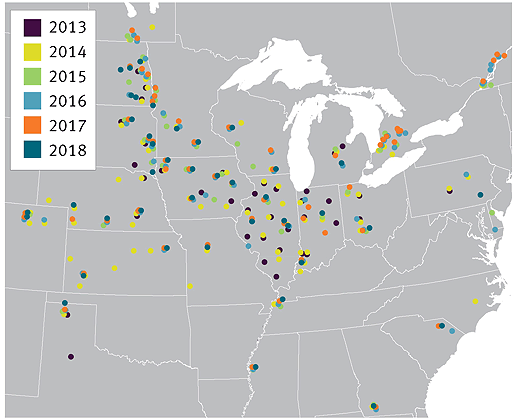
Figure 4. Pioneer plant population test locations in North America, 2013-2018.
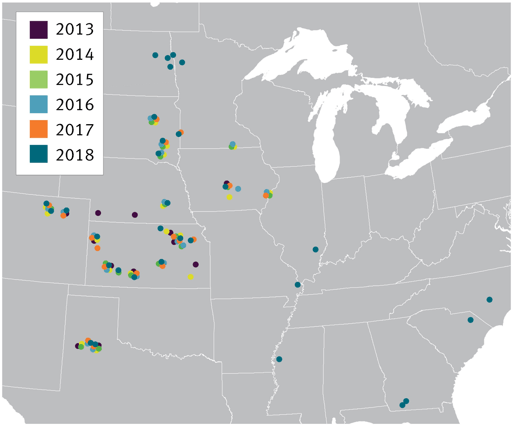
Figure 5. Pioneer water-limited plant population research locations in North America, 2013-2018.
Additionally, hundreds of on-farm Pioneer® agronomy seeding rate trials are conducted each year comparing multiple corn products at up to four seeding rates at each location. These trials have considerable value for local observation, evaluation and refinement of plant population agronomic response. Farmers can use the multi-year and multi-location results to identify the best potential planting rates specific to their hybrid, location, and management practices.
Field Productivity Level
In general, corn hybrid response to plant population follows a quadratic response model in which yield increases with greater plant population up to an optimum point, beyond which yield declines. Pioneer research has shown that yield response to plant population depends on the yield environment. An analysis of 15 years of plant population response data showed that in low yielding environments (below 100 bu/acre), maximum yield was attained at a plant population level of 24,000 plants/acre. In very high yield environments (above 200 bu/acre), yield response to plant population continued to increase even at 40,000 plants/acre (Figure 6).
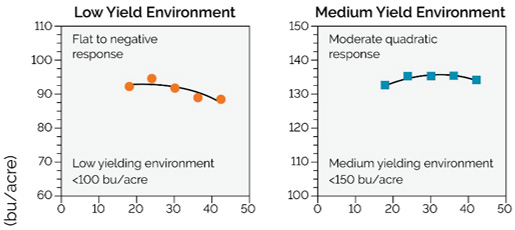
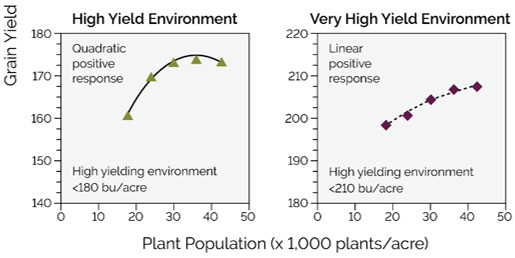
Figure 6. Corn hybrid response to plant population under four yield environments, a) low yielding <100 bu/acre; b) medium yielding 100-150 bu/acre; c) high yielding 150-180 bu/acre; and d) very high yielding 190-210 bu/acre (Ciampitti, 2018b).
Economic Optimum Seeding Rate
As yields increase with each increment of higher seeding rate, a point is reached where the yield benefit from the next addition of seed no longer exceeds the cost of the seed. That point is the optimum economic seeding rate. By definition, it is the seeding rate that generates the most income when seed cost and grain price are factored in. The economic optimum seeding rate will always be less than the seeding rate at which yield is maximized.
Results from recent Pioneer plant population research show that the economic optimum seeding rate increased from approximately 30,000 seeds/acre at the 150 bu/acre yield level to around 37,000 seeds/acre at the 240 bu/acre yield level (Figure 7).

Figure 7. Corn yield response to population and optimum economic seeding rate by location yield level (7-yr average of all hybrids tested). (Averaged across all hybrids tested. Economic optimums based on a corn rain price of $3.50/bu and a seed cost of $3.00 per 1,000 seeds; assumes 5% overplant to achieve target population.)
At water-limited locations where yield levels were lower, economic optimum seeding rate varied from less than 22,000 seeds/acre for locations yielding 90 bu/acre to around 24,000 seeds/acre for yields of 150 bu/acre (Figure 8).
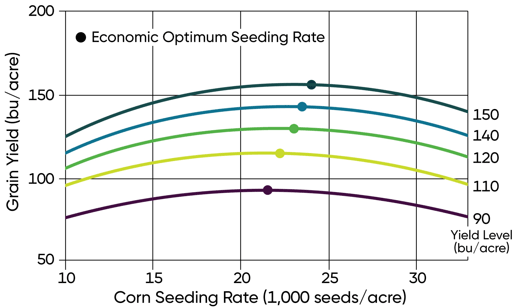
Figure 8. Corn yield response to population and optimum economic seeding rate by location yield level at water-limited sites, 7-yr average. (Averaged across all hybrids tested. Economic optimums based on a corn grain price of $3.50/bu and a seed cost of $3.00 per 1,000 seeds; assumes 5% overplant to achieve target population.)
Hybrid Maturity
Research has generally shown a higher optimum plant population for shorter comparative relative maturity (CRM) hybrids. Some researchers theorize that the disadvantages of smaller stature and lower leaf area index of early maturity hybrids are alleviated by higher populations. Increasing leaf area index may be required for highest yields in northern areas with limited light availability during late ear-fill stages.
An analysis of 15 years of Pioneer plant population research data showed that corn yield was generally lower and optimum population was greater with hybrids of shorter CRM. Long (106-115 CRM) and very long (>115 CRM) maturity hybrids generally reached their maximum yield within a very narrow plant population range of 34,000 to 35,000 plants/acre. On the opposite CRM range, very early to medium (<78 CRM to 105 CRM) maturity hybrids typically achieved maximum yield at plant populations ranging from 36,000 to 39,000 plants/acre.
Pioneer Planting Rate Estimator
The Pioneer Planting Rate Estimator, available on www.pioneer.com, allows users to generate estimated optimum seeding rates for Pioneer® brand corn products based on data from Pioneer research trials. The Planting Rate Estimator provides flexibility in customizing the graph display based on grain prices and seed costs.
The Planting Rate Estimator has the ability to display population response curves for a wide range of yield levels, which can provide guidelines for creating variable rate seeding prescriptions. It is possible to display plant population response curves at 10 bu/acre increments for all yield levels where there was a statistically significant response based on the available research data. The yield levels available for display will vary among hybrids based on the available research data. Users also have the option of selecting a “Water-Limited Sites” version of the planting rate estimator, which includes data from studies conducted in drought environments in the Western U.S. Farmers should use the Planting Rate Estimator as an initial guide and work with your Pioneer sales professional for refinements based on local observations and on-farm trials.
Seeding Rate Tips
Challenging growing environments may reduce corn plant populations below optimum levels. These conditions can occur when planting into no-till or high-residue seedbeds, or cloddy or compacted soils. Soil-borne diseases and soil insects can also diminish stands. All of these factors can interact to challenge stand establishment, and effects are magnified when planting early into cold, wet soils. Therefore, consider the following points when choosing your seeding rate:
- In general, plan to drop 5% more seeds than the target population to account for germination or seedling losses.
- Boost target seeding rates by an additional 5% for extreme or challenging environments such as those described in the paragraph above.
- In areas with perennial drought stress, seeding rate targets are lower. Base your seeding rate on the specific hybrid population response at the historical yield level of the field.
- Consult your Pioneer sales professional for optimum economic seeding rates of each Pioneer® brand hybrid, as well as hybrid placement tips and other helpful management suggestions.
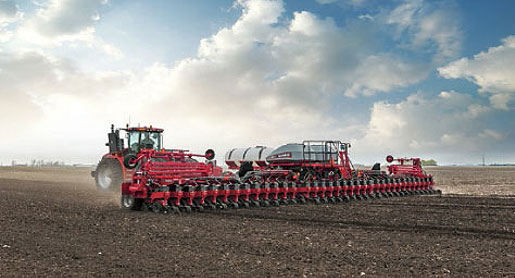
Photo courtesy of CNH.
References
Ciampitti, I. 2018a. Trends in Optimum Plant Density and Yields Gains for Corn in North America. Pioneer Agronomy Research Update.
Ciampitti, I. 2018b. Corn Hybrid Response to Plant Population: A Review for North America. Pioneer Agronomy Research Update.
The foregoing is provided for informational use only. Please contact your Pioneer sales professional for information and suggestions specific to your operation. Product performance is variable and depends on many factors such as moisture and heat stress, soil type, management practices and environmental stress as well as disease and pest pressures. Individual results may vary.
PIONEER® brand products are provided subject to the terms and conditions of purchase which are part of the labeling and purchase documents.
March 2019